Ancient Centres of Learning
Indian Temples – Universities and Libraries Carved out of Stone
One of the greatest misunderstandings about Indian temples is that they are merely places of worship. But if you really begin to explore and immerse yourself in what they truly represent, you’ll realize that temples aren’t just religious structures; they are libraries in stone, centers of healing, schools of philosophy, wellness retreats, cosmic energy fields, centers of art, music, dance, sadhana, worship, occult, festivals, justice, and commerce—all in one.
S. N. Balagangadhara: The Colonial Construct of “Religion”
S. N. Balagangadhara, in his work The Heathen in His Blindness…: Asia, the West and the Dynamic of Religion, points out how “religion” is a colonial construct that does not universally apply to Indian traditions. Colonial discourse imposed the idea of religion on India, mischaracterizing its spiritual traditions as religions. Thinking of temples only as places of worship is therefore a complete misunderstanding.
Prana Pratishta: The Temple’s Living Core
Another important facet of the temple tradition is the complex process of Prana Pratishta—the highly technical and scientific process of invoking and establishing divine cosmic energy in the Murti. Without Prana Pratishta, a temple might be an architectural marvel, but it remains energetically inert. When done properly, the murti “comes alive,” radiating the subtle forces that nourish the devotee’s entire being! We have temples that are more than 1500 years old and that still radiate that divine cosmic energy. Have you ever stood in front of the Hoysaleshwara Linga or the Shantaleshwara Linga. Have you prostrated in front of the huge 1000 year old Shiva Linga at the Brihadishwara? Have you experienced the energetic bliss of the Devi at Kanchi Kamakshi Temple, Madurai Meenakshi Temple, Kolluru Mookambika Temple or at Sri Kalahasti? This is neither simply history or an unexplainable mystery. It can be a part of your experience even today with the right guidance from those who know! And we have many such men and women who are masters of Yogic and Temple Science. Yes! It is science!
Idol Worship: A Misunderstood Concept

Many people deride this as idol worship. There is a well-known anecdote from the life of Swami Vivekananda. When he arrived in Alwar, Maharaja Mangal Singh—proud of his modern ways—mocked the monk’s “beggar’s life” and labeled idol-worship meaningless. In response, Vivekananda pointed to a portrait of the king’s father and asked someone to spit on it. Furious, Mangal Singh realized the painting was simply a symbol of his father, just as an idol is a symbol of God. Humbled, he apologized and understood the essence of idol worship. Source: “Real Meaning of Idol Worship,” VivekaVani, January 19, 2019. Image source: Wikipedia
In yogic meditation, a murti helps represent the “idea vision” of God per the tradition of that temple. It helps focus all your mental energies on a chosen ideal. In essence, “You become the object of your meditation.” In other words, you are not “worshipping” a stone idol. You are using the “murti” to help you focus your mind on that which the murti represents. Also, since the murti is “alive” with Prana (the same Prana that animates all life) it is not a mere piece of stone. In any case, in from the Sanatani perspective, everything is a modulation of the same consciousness. Everything has consciousness and everything is conscious. Other examples of symbols considered sacred or worthy of respect include the national flag of a country or an image of its founder or national father, all of which people hold in deep reverence as representations of something greater.
Sacred Geometry: Aligning Architecture with Cosmic Harmony
Vastu Shastra says, “Geometry exists everywhere in the cosmos, and it forms the root of all creation.” This resonates with the idea of sacred geometry, which bridges the gap between architecture and spirituality by aligning structures with cosmic harmony. Sacred geometry is therefore the foundational design principle that makes temples places where cosmic energy naturally converges.
Historical Context
The ritual geometry tradition indeed goes back to the Shulba Sūtras (part of the Vedic corpus). The Āgamas further codified temple building methods. The Shilpa Śāstras do view geometry as central to invoking cosmic order in sacred structures. Temple designs employ mandalas and yantras, often in complex repeating patterns that modern observers liken to fractals.
Key Concepts in Sacred Geometry
• Mandala and Vastu Purusha Mandala: These diagrams represent the universe. Vastu Purusha Mandala maps out the temple’s layout, aligning it with cosmic forces. The central point, Brahmasthana, is the holiest part, where the main deity (Murti) resides, embodying the temple’s spiritual core.
• Fractals and Self-Similarity: Think of an infinity mirror—repeated, self-similar patterns. This mirrors the idea that each part of the universe contains a replica of the whole—the cosmos is holonomic.
• Yantras: These mystical geometric diagrams harness and channel divine energy. The Sri Yantra is particularly important in our spiritual and tantric tradition. Temples like Meenakshi Temple in Madurai and the Khajuraho Temples incorporate yantras to amplify spiritual power.
Case Studies in Sacred Geometry
1. Kandariya Mahadev Temple, Khajuraho (Madhya Pradesh)
A textbook example of fractal geometry. Smaller replicas of the main shikhara reappear in scaled-down forms. This “nested” design reminds us of the universe’s endless interconnectedness. Image: Wikipedia.
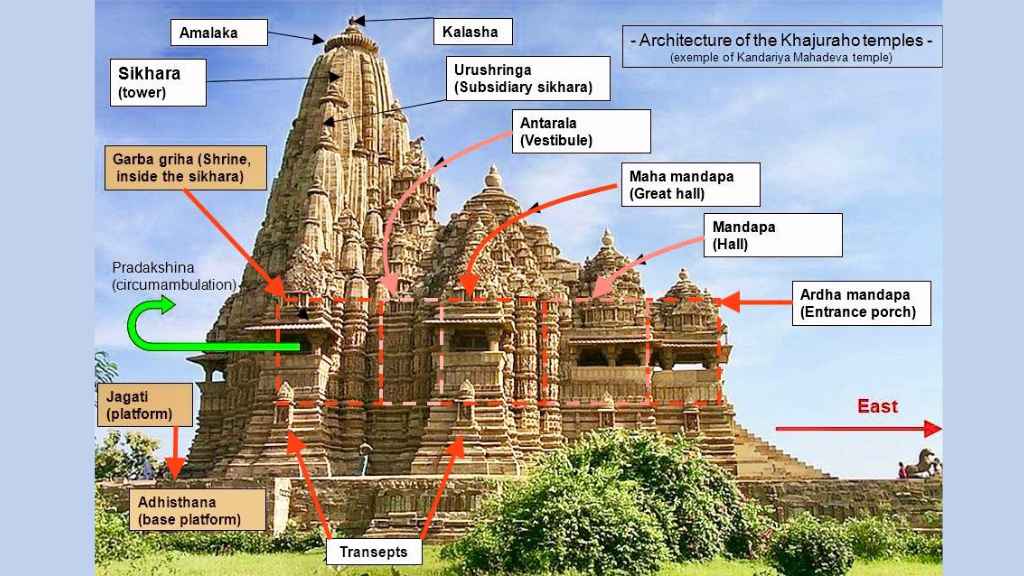
2. Brihadeeswarar Temple, Tanjore
A UNESCO World Heritage Site, the temple’s layout aligns with cardinal directions. The towering vimana represents a channel linking Earth to the divine cosmos, all based on precise mathematical and sacred geometric principles. Image source: Wikipedia.
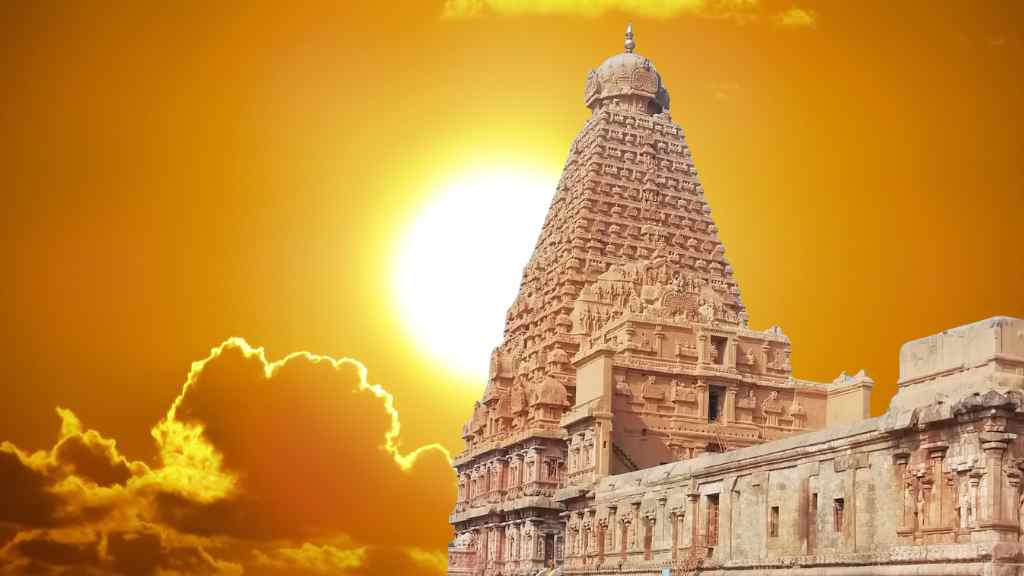
3. Sun Temple, Modhera (Gujarat)
Notable for its astronomical alignment. It employs a 64-grid mandala representing the 64 arts in Sanatana philosophy. The layered, concentric design reflects a worldview of cosmic expansion from a central point. Image source: Wikipedia.
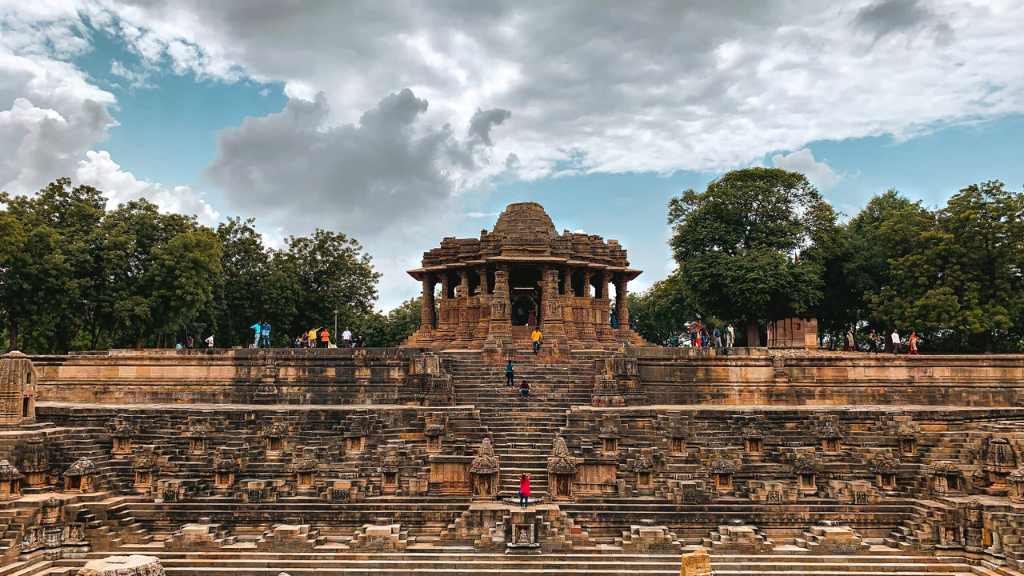
4. Meenakshi Temple, Madurai
Known for intricate gopurams (gateway towers) that use self-repeating, fractal-like patterns, signifying the devotee’s ascent from mundane reality to spiritual transcendence. Image source: Wikipedia.
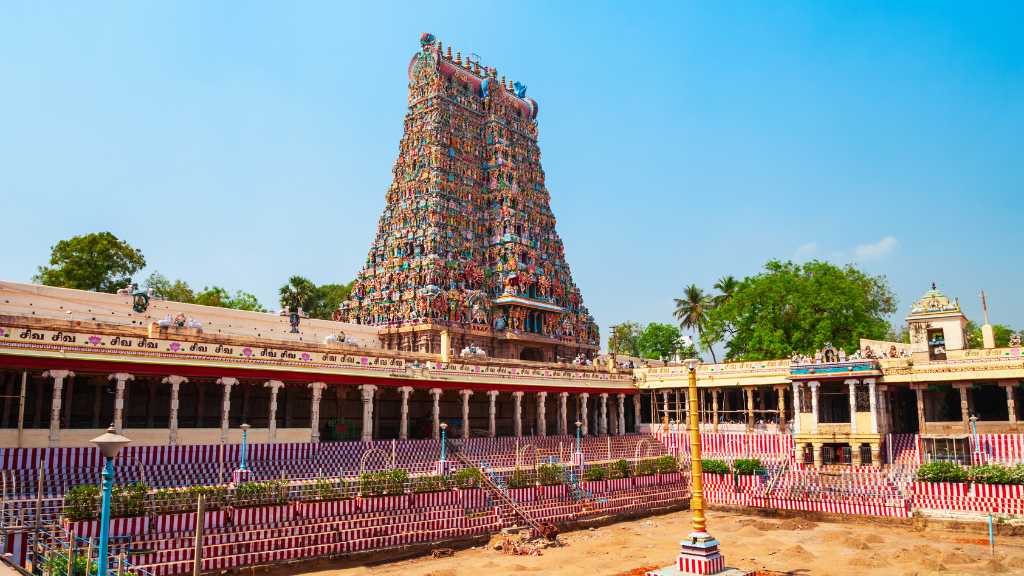
Deeper Dive: Hoysala Temples and Fractal Patterns
Chennakeshava Temple, Belur
• Dynasty & Date: Built by the Hoysala Empire in the 12th century under King Vishnuvardhana.
• Fractal-Like Elements: A complex, stellate (star-shaped) plan that repeats star points around the garbhagriha (sanctum). Intricate, nested carvings with multiple layers of ornamental bands. Repeated motifs—floral, mythological, and geometric—on progressively smaller scales. Image source: Wikipedia.
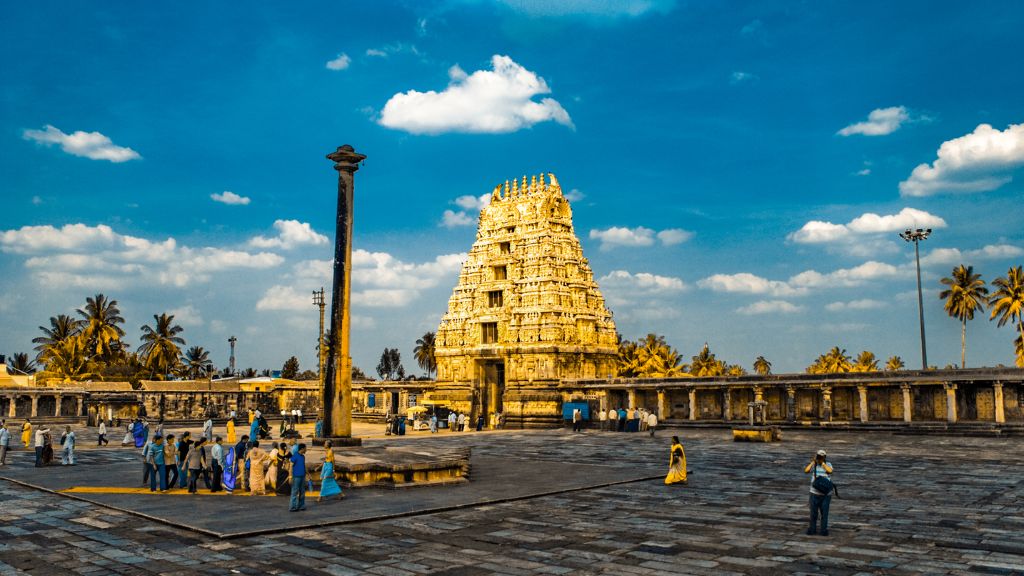
Hoysaleswara Temple, Halebidu
• Dynasty & Date: Also a 12th-century Hoysala creation, attributed to King Vishnuvardhana’s reign.
• Fractal-Like Elements: Double-shrine (dvikuta) plan featuring repeated star-shaped projections. Highly detailed carved friezes depicting rows of animals, mythological stories, and floral scrolls in tiers. Each tier mirrors and recasts similar forms, creating a visually recursive effect. Image source: Wikipedia.
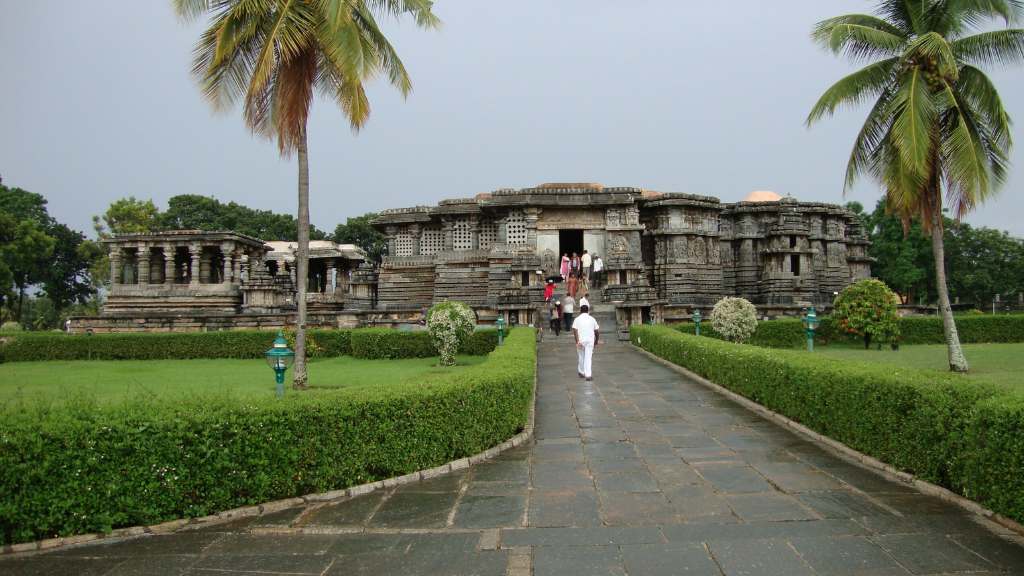
Keshava Temple, Somanathapura
• Dynasty & Date: Built in the 13th century under the later Hoysala rulers.
• Fractal-Like Elements: Another stellate temple with a trikutachala (three-shrine) plan, each shrine carrying a star-shaped base. Ornamental motifs repeated in multiple layers on the vertical walls. Recurring patterns of miniature temple towers (shikharas) sculpted along the external walls. Image source: Wikipedia.
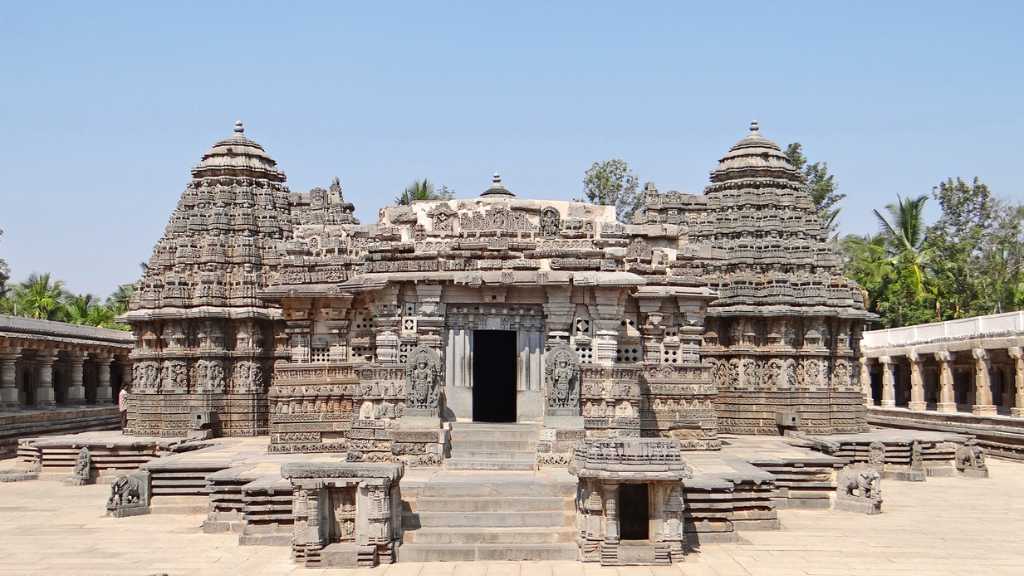
Lakshmi Narasimha Temple, Nuggehalli
• Dynasty & Date: Mid-13th century Hoysala architecture, built during the reign of King Vira Someshwara.
• Fractal-Like Elements: A star-shaped (stellate) ground plan. Sculptural reliefs on the outer walls showing repeated mythological scenes, each framed within ornate borders that interlock in a self-similar pattern. Image source: Wikipedia.
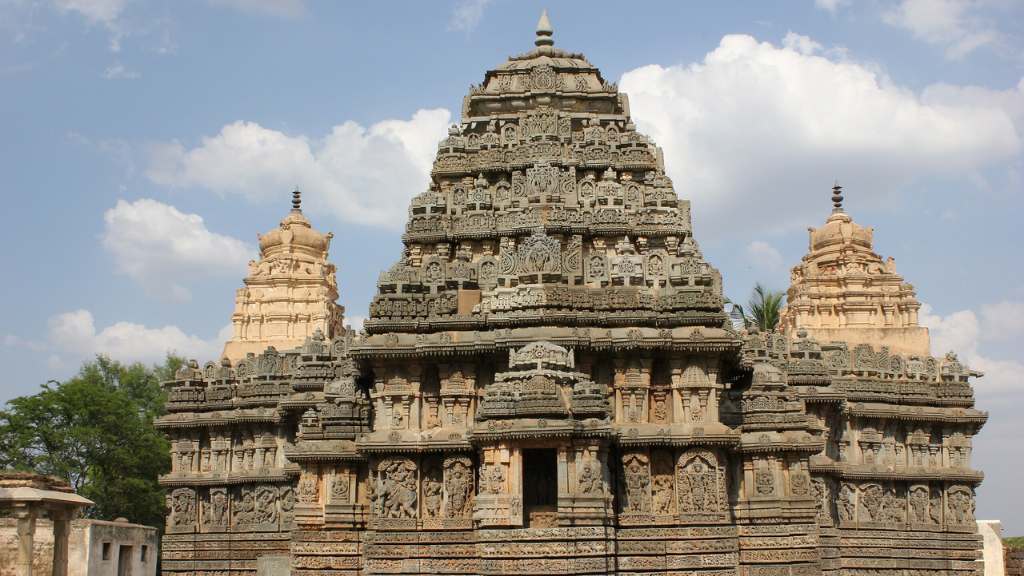
Modern Relevance
Sacred geometry’s influence endures in contemporary design, especially in sustainable urban planning. Architects adopt these millennia-old principles—golden ratio, symmetry, fractal patterns—to produce spaces that are aesthetically pleasing and energetically balanced. Aligning with “Yatha Pinde Tatha Brahmande” (As is the microcosm, so is the macrocosm), these design choices echo natural forms and cosmic proportions, instilling a sense of harmony in modern structures.
Beyond Architecture: The Multidimensional Purpose of Temples
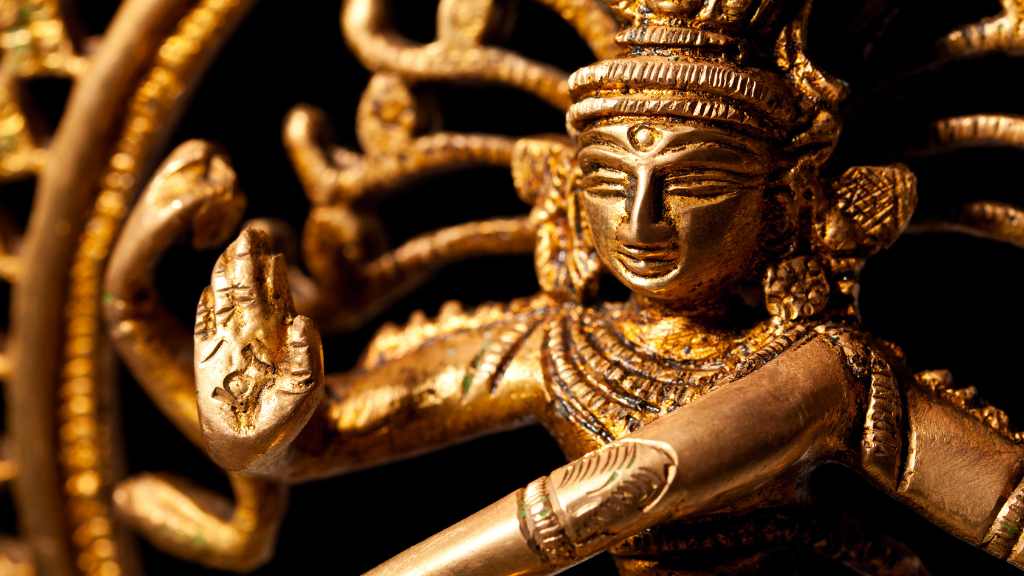
A temple is far more than a building; it’s a miniature cosmos encompassing Earth, Water, Fire, Air, and Space—the Pancha Bhootas—alongside the deity that presides within. Everything from the site selection to the idols, from the orientation to the rituals, is designed to induce inward focus and meditative states, aligning the visitor’s frequency with the temple’s.
Structure of the Temple
The universe is composed of the five elements—Prithvi (Earth), Jal (Water), Agni (Fire), Vayu (Air), and Akash (Space). Temples symbolically integrate these elements:
• Foundation as Earth
• Sanctum walls as Water
• Tower (vimana) as Fire
• Upper tiers as Air
• The unseen space above as Akash
Vertically, the sanctum (Garbhagriha) is the head or neck, while the lofty tower is the head, crowned by the Kalasha.
Why Temples Matter: Fourteen Key Dimensions
1. Libraries in stone: Preserving knowledge in carvings and inscriptions.
2. Places to bathe in cosmic energy: Built on geospots vibrating with Earth’s magnetic fields.
3. Therapy centers: They are therapy centers which are designed to set right the energetic balance of your body.
4. Wellness centers: They are wellness centers that help to ground and stabilize the mind and ready it for true yoga (as different from the asana focused yoga that is being marketed everywhere, especially in the west
5. Classrooms: They are places that teach and impart the key aspects of our philosophy, science, culture, cosmology and itihaasa to younger generations.
6. Introducing Rta to younger minds: They are also places that introduce younger generations to the natural and supernatural aspects of life and also the natural cycles of life and the deep esoteric meanings of what would generally be considered ordinary elements and activities of everyday life.
7. Community hubs: They can also be places where spiritually oriented people who know each other meet and also like-minded people with spiritual inclinations can meet and discuss matters of the beyond.
8. Divine arts: Just as in the past, they can once again be centres of divine art such as classical dance which was again used to raise consciousness of the audience through performance and also help people connect with the divine and enter samadhi.
9. Justice centers: Historically, disputes got settled under the divine gaze. They were often places were disputes were settled and as it was believed that people would be compelled to speak the truth in the premises of the temple and the divine forces would help reach a fair verdict.
10. Economic hubs: Supporting vendors and artisans. In fact temples were the center of life and economy in ancient times – even today a typical large temple support many vendors whose livelihood depends on the temples such as flower sellers, coconut sellers, garment stores, etc.
11. Hosts to key life events: Temples are also places where people celebrate birthdays, namakarana (naming ceremony), upanayana, weddings, shraddha etc 12. In many temples astrologers are available to help people decide the best time (muhurta) for auspicious events such as weddings and also for other rituals.
12. Astrological guidance: Many temples have astrologers on site to advise on auspicious timings.
13. Repositories of ancestral knowledge: Beyond all this temples are also great repositories of information of the way of life of our ancestors and are also a great attraction for students and scholars who are engaged in studying ancient Indian architecture.
14. Feeding communities: Annadana (free food) offered to visitors. A majority of temples provide free food and feed thousands of people daily (all depending on the size of the temple and who controls it – govt or a private trust).
15. Ambassadors of Ancient India to the world: Our temples can also serves as outstanding examples of what our civilisation has achieved in the past and can achieve in the future. In that sense, they can act as our ambassadors to the outside world.
Only by recognizing these facets do we reclaim the temple’s place as an integral part of our daily lives.
Journeying Through India’s Temples
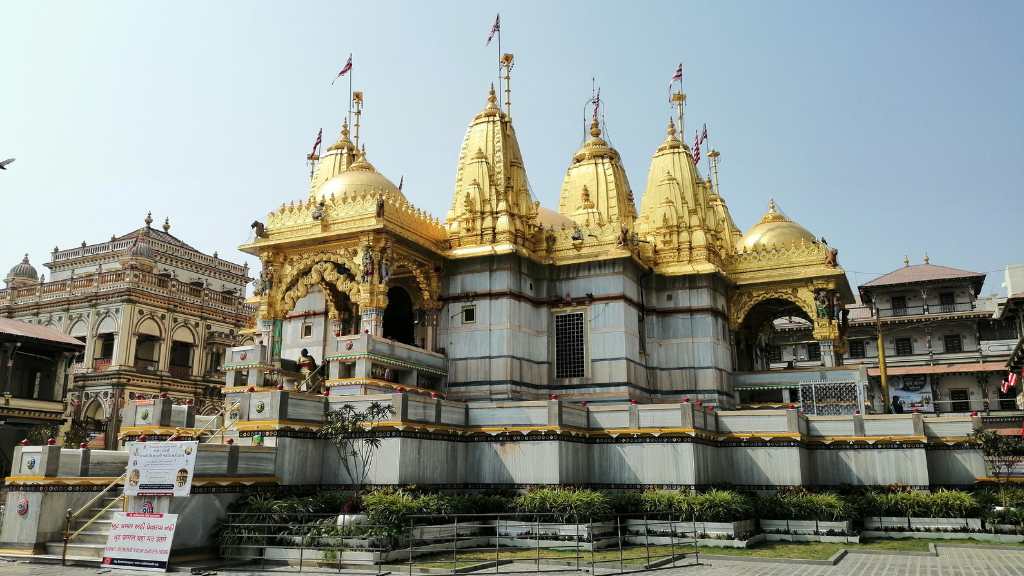
Visit as many temples across India as possible: Dharmasthala, Hampi, Kadri near Mangaluru, Udupi, Dharwad, Gadag, Mysuru, Bengaluru, Hasana, Gokarna, Palani, Madurai, Rameshwaram, Thanjavur, Sri Rangam, Thiruvannamalai, Horanadu, Guruvayoor, Thrissur, Kolluru, Varanasi (Kashi), Prayag, Gaya, Ellora, Ajanta, Mahabalipuram, Kalahasti, Tirupati, Pune, Pandharpura, Odisha, West Bengal, etc.—across the length and breadth of India. Try to cover at least 20–30 temples in one trip. That is when you will start noticing patterns. From North to South, from East to West, these temples share certain commonalities and reveal intriguing differences in design. Yet, there is always a definite, underlying blueprint.
For instance, walk through the streets of Kashi (Varanasi) and allocate at least 7 days for this walking tour. Don’t skip even a single temple, big or small. Meditate on the Dashashwamedh Ghat or the Assi Ghat. Kashi is itself a living Yantra. Every stone, every alley, and every shrine is intentionally placed. You will find yourself asking: How did they manage to build a city that functions as a Yantra in itself?
Design by Intention
“Design is a discipline of study and practice focused on the interaction between a person—a ‘user’—and the man-made environment, taking into account aesthetic, functional, contextual, cultural and societal considerations.”
As you travel around India, you will notice there is a certain design to everything—temples, buildings, houses, streets, shops, wells, and so on—all crafted with a deeper purpose. You cannot design something without a purpose.
The Sanatana temples are especially intricate. There is the complexity and intricacy of the temple architectural design and then there is the question of the technology, the human skills, manpower, and the sheer artistry of the sculptors who accomplished these feats of human engineering.
Try to visit the temples of Beluru and Halebidu in Hassan, Karnataka, and spend a good 4–5 days to “see” each and every inch of these temples. There is a certain thought, purpose, and intention behind every feature and every single sculpture—like a beautifully directed movie where not a single scene is wasted. These temples are cinema halls where the movies of our ancient glorious past have been playing nonstop for centuries, come rain or shine. The sculptors were the storytellers, and the kings and merchants who patronized and funded these temples were the producers.
Visit these temples multiple times over several days, each time wearing a different hat: first as a tourist, then as a researcher, then as a devotee, and finally as a sadhaka. You will notice different facets. Talk to the priests, the people who live around the temple, learn about the history, and note how your experience changes with your perspective. Now, do the same at 10–20 other temples in other parts of the country. Compile all your notes and pictures, and a story will come to life.
You will realize that a lot of time, money, and effort went into building each one of these temples. Why? Why did they put so much effort into building these temples? Why were they so important? And now think of the 40,000+ temples that were destroyed/occupied/modified by invaders. What secrets did they contain? What stories did they hide in their bosoms?
The Heart of Community Life
These temples were the center of life and activity in their respective cities. Can you compare them to other places of worship? Why or why not? After the why question, we have to tackle the how question: How did they do it? How did they pull off the seemingly impossible feats of building such massive, intricate, and meticulously crafted temples? And who were these people who built these marvels?
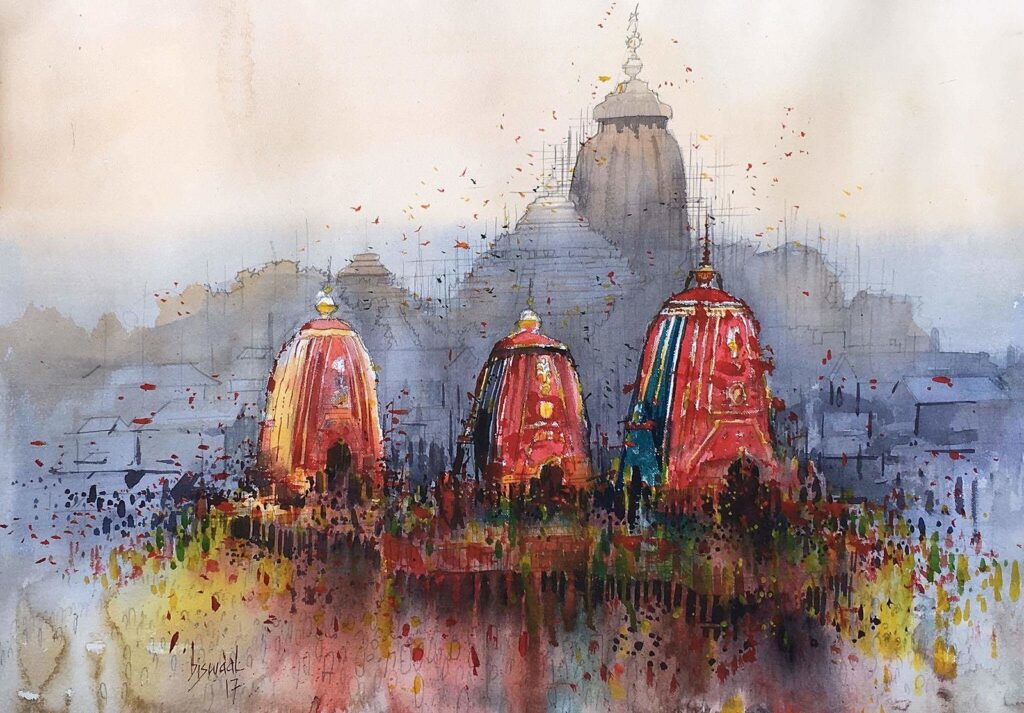
Image courtesy: https://commons.wikimedia.org/wiki/File:Rath_yatra.jpg
At this point, you realize temples were libraries in stone, cinema in stone, divinity in stone—centers of art, music, sadhana, worship, occult, festivals, justice, and commerce. To carve entire knowledge libraries and features that produce divine experiences (even today), what might the sculptor have studied? Where did they study, under whom, and how was this knowledge passed on through generations despite wars, famine, foreign occupation, and colonial rule? How were the stones chosen and moved to the temple sites?
Surely, these were no ordinary sculptors, no ordinary workers, certainly no ordinary kings. And what can we infer from our understanding of the design of these temples and the study of the materials used and the technologies applied?
Most importantly, what can we infer from the experiences we have even today in temples built 1,000–2,000 years ago? We are able to build rockets that take us to the moon and other planets, but we cannot build another temple like Kailashnath, Brihadeeshwara, or the Chennakeshava temples. Why is that?
Conclusion: A Pathway to Higher Consciousness
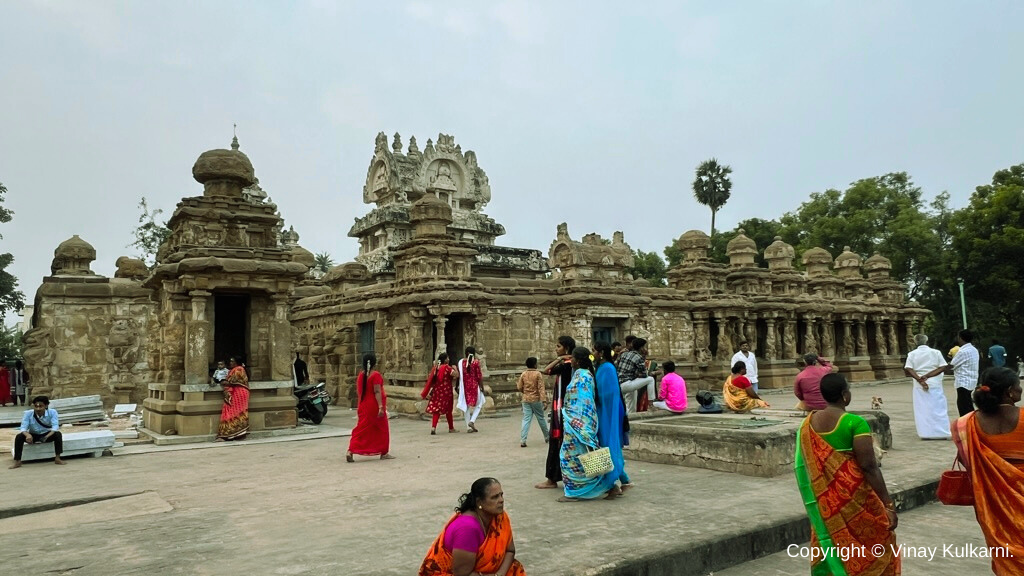
The minute you stop thinking of temples as merely religious structures, a whole world of possibilities opens up—for businesses committed to employee wellness, for schools eager to impart cultural and spiritual education, and for families seeking to enrich their lifestyle with subtle energy experiences.
Indeed, the Siva Sutras declare:
“Chittam Mantraha.” (1) चित्तं मन्त्रः।। (Chittam Mantra)
(a) With intense practice, the mind becomes the mantra, reflecting the Real.
(b) Individual consciousness conforming to a mantra attains the goal seeded within that mantra.
(c) Mantra is a method to give individual consciousness an exposure to the supreme consciousness.
And the temple is the best place to experience this convergence of mind, mantra, and higher reality. By exploring sacred geometry, fractal designs, Vastu Purusha Mandalas, and the multidimensional roles temples have played for centuries, we find a path that unites ancient wisdom and modern innovation—a path that enriches us intellectually, emotionally, and spiritually.
Ultimately, temples are gateways for realizing the profound harmony that underlies all creation, connecting us to the cosmos and illuminating the possibilities of a life lived in alignment with the divine. So, what can you infer from the design of our ancient temples and monuments? Perhaps it is time we rediscover this design knowledge and re-apply it—not merely to build structures, but to construct experiences that elevate and transform humanity as a whole.

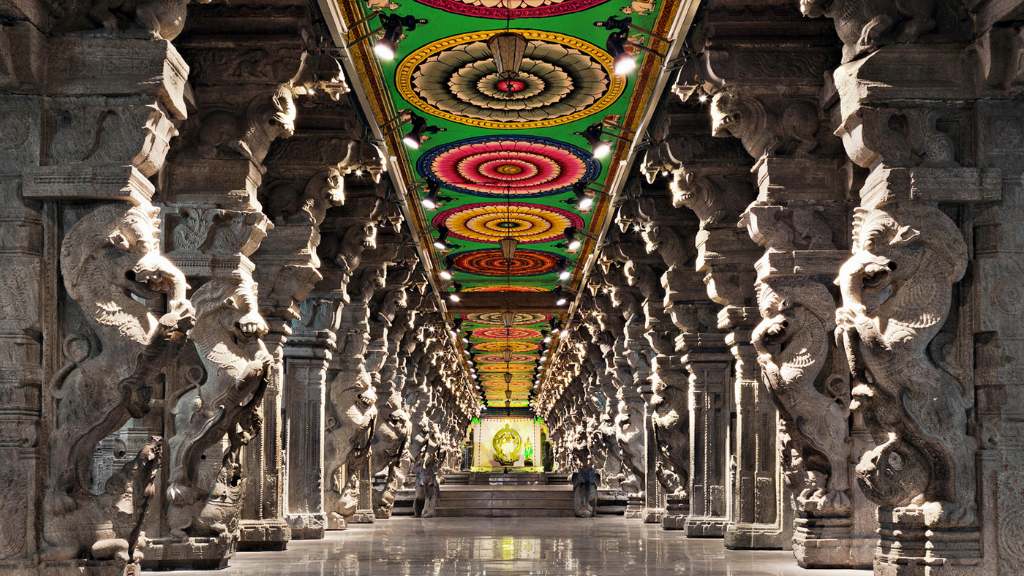
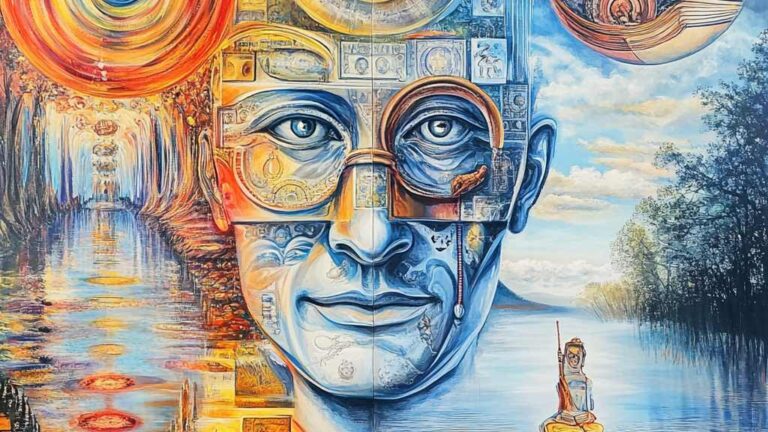
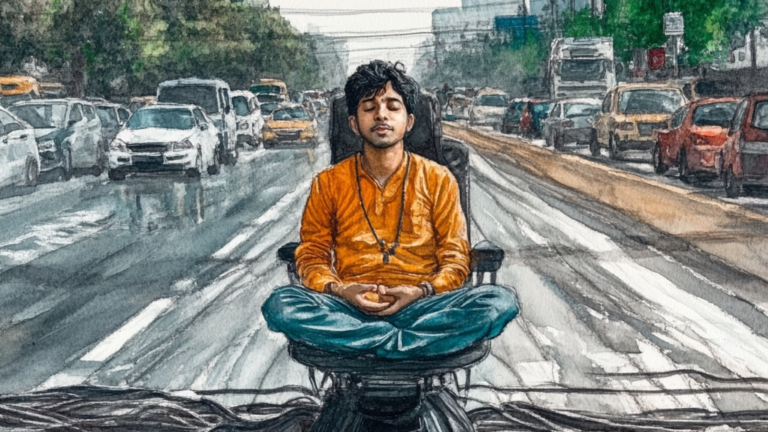



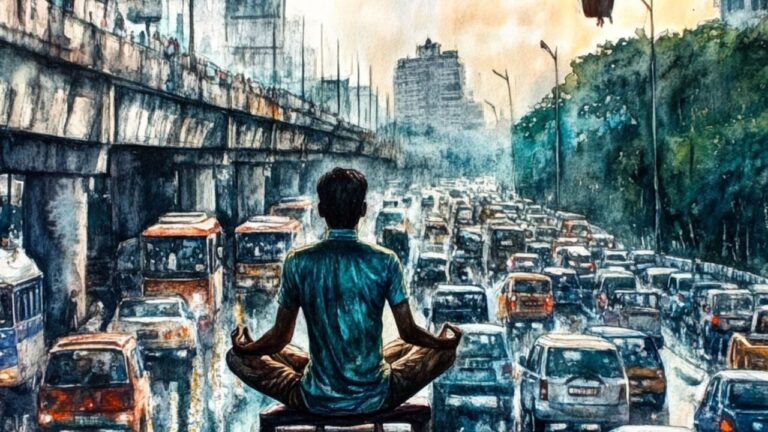
fps1a6